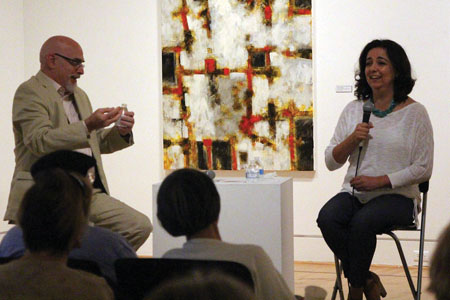
With communities rapidly changing and the make up of various populations becoming more diverse, museums face an interesting conundrum. Instead of simply showcasing what has always been the status quo, they’re looking deep into the fabric of their patrons and trying to find a balance of giving a voice to underserved groups and staying true to themselves.
In a Coffee with the Curator on July 27, Triton Museum of Art Chief Curator Preston Metcalf and Curator of Education/Museum Curator Ester Fernandez discussed the steps museums must take in order to create parity in the art world – starting with looking at the museum itself.
In the past few years, the Triton has showcased artists who may not typically have a seat at the table. In 2013, the Triton’s Echoes of Islam exhibit gave a voice to a growing and often discriminated group of artists. The group show, led to solo shows for two of the artists, Karim Alwali and Salma Arastu – not because the Triton needed to diversify the artists it shows, but because the artists had a voice and that voice needed to be heard.
However, Metcalf discussed how that might not always be the case. He told a story about when he worked at another museum and at that time the executive director walked into a staff meeting and was specifically seeking an African- American artist for a show. The director felt the museum needed to show a minority artist – any artist. In randomly picking someone who fit the profile, the show was a disaster, and that becomes the conundrum. Do museums exhibit artists because their work needs to be seen or do they randomly pick artists because their racial, ethnic or religious background fits into a buzzworthy conversation topic?
If we all accept that museums are educational institutions then we really need to grapple with are we really representing our community? said Fernandez. For me it’s not even a question.
Museums have changed from the 18, 19th Century model of see how powerful we are to see who we are, responded Metcalf. And you’re saying that as an educational institution it’s our role to reflect the reality of who our community is rather than who certain portions of our community may wish it was.
The curators discussed how museums can be cognizant of the need for parity without resorting to tokenism, or showing an artist because they fit into a mold.
I think we all see moments in our lives when we come to the realization that geographic boundaries mean nothing; skin color means nothing and this could even apply to the most ardent racist, said Metcalf.
Metcalf’s statement became the definition of what parity truly is. Good art is good art. Great art is great art and no amount of wishing and hoping and placing artists into a category based on background will change that. If skin color means nothing, and museums realize that it’s not about pleasing a group of people or showing an artist for political reasons, then the art world is one step closer to parity. Eventually it will happen, said Metcalf, but for now it’s a work in progress.
The next Coffee with the Curator will be Monday, Sept. 28 from 8 to 9:15 a.m. Metcalf will discuss the importance of public art within the community. Admission is free for museum members and $5 for non-members. Visit www.tritonmuseum.org for more information.





